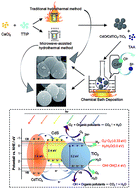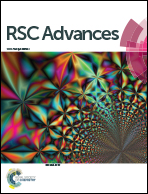Litchi-like CdS/CdTiO3–TiO2 composite: synthesis and enhanced photocatalytic performance for crystal violet degradation and hydrogen production†
Abstract
Using the programmed temperature hydrothermal or microwave-assisted hydrothermal method combined with the ion exchange method, a series of CdS/CdTiO3–TiO2 composites were prepared by adjusting the Cd : Ti element molar ratio and microwave synthesis conditions. The crystal structure, morphology, and surface physicochemical properties of the as-prepared composites were well characterized by X-ray diffraction (XRD), UV-visible diffuse reflectance spectroscopy (UV-vis/DRS), X-ray photoelectron spectroscopy (XPS), scanning electron microscopy (SEM), high-resolution transmission electron microscopy (HRTEM), and N2 adsorption–desorption measurements. The results showed that the composites prepared under different synthesis conditions contained mixed crystal phases of CdS, CdTiO3 and TiO2; moreover, compared to samples prepared by the programmed temperature hydrothermal method, the conditions of the microwave-assisted hydrothermal synthesis showed greater impact on the as-prepared CdTiO3 phase. The as-prepared composites basically showed a litchi-like structure, in which CdS/CdTiO3–TiO2 synthesized by the programmed temperature hydrothermal method had a smoother surface, but the dispersibility of the particles was not favorable, while compared with the composites just mentioned above, the CdS/CdTiO3–TiO2 composites prepared by the microwave-assisted hydrothermal method possessed a coarser surface, more irregular particles and better separation conditions. Simultaneously, compared with the monomer CdS, the Brunauer–Emmett–Teller surface area of these composites increased remarkably, and the optical absorption extended to the visible region. Moreover, a series of CdS/CdTiO3–TiO2 composites were tested under multiple conditions including ultraviolet light, visible light, simulated solar light and microwave-assisted irradiation to study the photocatalytic properties towards crystal violet (CV) photodegradation. The results showed that the composites presented the best photocatalytic activity when the microwave synthesis conditions were 160 °C for 6 h with 0.4 : 1 (40%) Cd : Ti molar ratio. Meanwhile, the composite also had an excellent photocatalytic hydrogen production capacity. According to trapping experimental results, we proposed the possible mechanism of the photodegradation and photocatalytic hydrogen production in aqueous systems.


 Please wait while we load your content...
Please wait while we load your content...